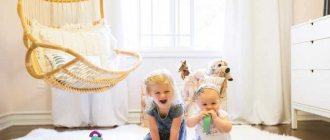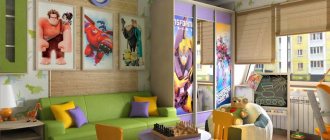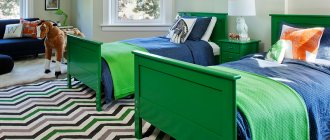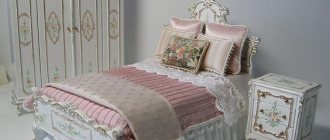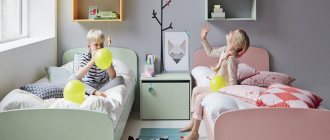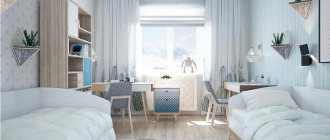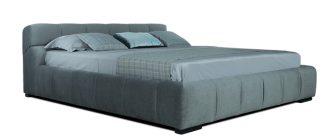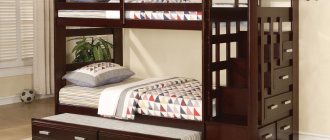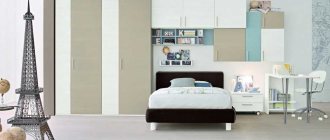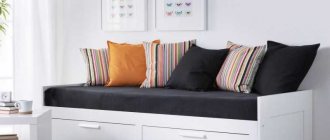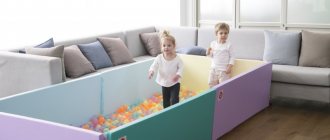Design Features
A children's bed from 3 years old should differ from the adult version. It is the features of the product that are responsible for the baby’s safe sleep. Among the main requirements for arranging a sleeping place are ergonomics. This is the most important characteristic, since a child’s skeleton is formed during sleep. It is necessary that the bed is as comfortable as possible and suitable for height and age.
What else you need to pay attention to:
- No sharp corners. All frame parts must be rounded, this affects the safety of the berth.
- The height of the product should be small; it should be comfortable for children to get out of bed. Fulfilling this condition will also protect you from injury in case of an accidental fall.
- Availability of sides. Children under 3-4 years old need this type of bed to protect them from falling during restless sleep.
- Structural strength. Restless children love to jump on the bed or rock it.
- The material from which the product is made. It must be environmentally friendly. In this case, the most suitable option is made of wood.
In order for a child to go to bed with pleasure, the design of the bed should be interesting. Thematic design models, such as a car or a house, are suitable. But it is unacceptable to have small design details that could be broken off. This is due to safety, since children love to tear off pieces and put them in their mouths.
A homemade bed must also meet all of the above requirements.
No sharp corners
Low product height
Availability of sides
Structural strength
Environmentally friendly material
How to choose the right bed for a child – what to consider
To select a high-quality model, you must adhere to the main criteria that it must meet:
- cleanliness in environmental terms: materials must not be hazardous to health, otherwise the bed will simply be unsuitable for sleeping;
- sides: an optional component, but still with them the child will be protected from an unexpected fall at night (it would be nice if their height was at least 10 cm);
- height of the sleeping area: selected according to age, therefore, for the tiniest children you should not choose tall models, as the child may accidentally fall and get injured;
- the dimensions of the base and mattress must match each other;
- It would be nice to select models with additional functions and elements (drawers, tables, etc.) - this will make it possible to make maximum use of the space occupied for sleeping.
How to choose the size of a place to sleep
To choose the size of a place to sleep according to the rules, you need to take age into account.
- Up to 3 years, a base length of 1.2 m and a width of 0.6 m is considered good.
- From 3 years to school age, the recommended length of the bed is 140-190 cm, and the width is 70-80 cm.
- For teenagers, it is better to purchase furniture with dimensions of 80x190 or 90x200, which is considered a full-fledged place to sleep for an adult.
During the school period, children grow quickly, so most people prefer to immediately replace the playpen with an adult-sized bed. But for a growing child, a place to sleep “for growth” may not be a suitable solution due to the design properties of certain models. You can solve the problem by purchasing sliding furniture, which will free parents from the need to buy a new bed for their child every couple of years.
Types and adaptation of the bases of sleeping places for children's beds
The quality of sleep for babies depends on the base of their bed. The bottom of the bed is selected depending on the characteristics of the child and his physical health.
- Flat base. It is made from solid plywood sheets, chipboard, fiberboard or ordinary wooden boards. It is believed that such a bottom has already outlived its usefulness and is not very convenient compared to modern designs. It is also worth saying that such a base does not allow the mattress to ventilate, which will cause poor sleep for the child.
- Rack bottom. The slats are fixed to the stock frame perpendicular to the width. The gaps between them allow the mattress to allow air to pass through, thus providing a proper ventilation system while sleeping. Often such a base is equipped with additional clips, which make it possible to adjust the degree of rigidity of the bed.
- Base with slats. This bottom is considered an excellent option, as it provides a great orthopedic effect. Its frame is made of metal, and the slats are made of bent laminated birch veneer. The slats are fastened to the frame using specialized reinforced holders. This design significantly reduces the load on the spine. The selection of a base on lamellas must be approached seriously, since not all manufacturers will be honest in its production. The step between the slats should not be greater than the width of the beams themselves, and the appropriate number of them for the entire length of the bed is 15 pieces or more.
Which mattress to choose for a children's bed - types
A well-chosen mattress is an important factor in getting a good night's sleep. It can be made with or without spring filling. Each type has its own specifics, which determine how comfortable the bed will be for a child.
Springless mattresses can be filled with:
By request, the next post will be on the topic of purchasing a bunk bed with a sofa below for parents. We believe you will like it.
- latex: good ventilation system, plasticity, moisture resistance;
- wool: warmth, average level of ventilation;
- coconut coir: wear resistance, naturalness, environmental purity, great orthopedic effect;
- felt: environmentally friendly, wear-resistant;
- spunbond: moisture resistance, long service life.
There are 2 types of mattresses with springs.
- With dependent spring block. The parts are connected by a rigid frame. There are about 150 springs per 1 m2, which ensures equal rigidity around the perimeter of the mattress. But its edges remain hard, which can cause confusion while on vacation. Over a certain period of time, the sheet loses its rigidity and may sag, but the cost of such models is not high, so you can always replace the mattress with a new one.
- With independent block. The principle of the device is similar to the previous type, but the springs are not connected to each other. The rigidity of a mattress can vary greatly, depending on the density of its filling and the shock-absorbing qualities of the springs themselves. This type of product is classified as orthopedic, which is why its cost is much higher than other products.
The design of mattresses without a spring mechanism varies widely. The same materials are used to fill them as for products with springs, but there are no shock-absorbing parts themselves. The important advantages of springless models are:
- comfort;
- equal load distribution;
- hypoallergenic;
- long service life;
- noiselessness.
High price and low level of softening are the distinctive disadvantages of mattresses without a spring mechanism.
A spring mattress with an independent block, which has all the necessary orthopedic qualities, is perfect for furniture for children.
Popular models
The choice of cribs is great. Among all the diversity, several popular types can be distinguished. They differ in their functionality, size and complexity of assembly.
Standard single with sides
The most common option is a single bed. It is intended for one baby and will look natural in a children's room with any interior. Such models are equipped with protective sides, which is suitable for a small child from 3 years old. Advantages: low price, ease of assembly. The disadvantage is its low functionality, since the bed does not have additional accessories.
Transformers
These are complex multifunctional structures. During the day, this model can be turned into a table, and at night, it can be used as a regular bed. Due to the fact that the height of such furniture is quite large, it is equipped with sides. Some of them can be increased in length. This is very convenient, since as the child grows there will be no need to purchase a larger bed; you will only need a mattress of the required length. However, it is worth considering that the width of the bed will remain the same. Cons: large design dimensions and high price. The transformer can be used for children from 3 years old, but there are also very small models for newborns.
For the bed to last a long time, the quality of the transformation mechanisms must be high.
Roll-out
The specific design of the roll-out model (matryoshka) is that the sleeping place is hidden in a niche. At night it pulls out and becomes a full-fledged bed. There are designs designed for two, three and even four children, which is very convenient for large families. In this case, each sleeping place is rolled out slightly higher than the previous one.
They can be installed in small rooms, which significantly saves space. The lower roll-out tiers are low, so it will be safe for small children from 3 years old to sleep on them. Older children sleep on the upper beds. The main disadvantage is the need for daily unfolding, which can lead to breakage over time. To avoid problems during operation, when choosing, you need to pay attention to sliding mechanisms and their quality.
Bunk
Ideal for families with two children living in one room. This model saves space in the room. There are different designs, for example, a corner one is popular, in which the sleeping places are located perpendicular to each other. A very practical furniture option is bunk beds for children from 3 years old with drawers for storing things or linen.
Which car bed to choose for boys and girls, tips
A mandatory design element is the sides on the second tier (at least 30 cm), which will ensure the safety of a child of any age while sleeping. Suitable for children no more than four years apart. The only drawback is that if the room is too warm, then the child may feel very stuffy on the top floor.
The age categories are different: babies from 3 years old can be placed on the bottom crib, and older adults (from 6 years old) can be placed at the top. According to generally accepted standards, it is not customary to send small children under 6 years old to the upper tier, especially if they often wake up. As a safety net, the stairs must be equipped with handrails. You can also use rope mesh from the side to the ceiling.
With drawers
Manufacturers often add drawers to any type of children's beds. They can move out in different directions. The location option should be chosen taking into account the layout of the room:
- drawers roll out to one side if the bed is installed against the wall on one side;
- extend to both sides of the bed if the furniture is installed with its back to the wall;
- extend in the direction of one of the headboards if the supports are decorated with legs;
- as part of a set, when racks with shelves and drawers are located above the bed.
This additional furniture feature is designed to store various items, from bedding to toys. Their size is chosen depending on the filling. For example, teenage beds with small drawers are suitable for storing writing instruments, notebooks and textbooks.
When choosing, you need to take into account that for large drawers it is better to choose a design with wheels, and for medium ones - guide elements.
Attic
A distinctive feature of this model is functionality. These kids beds with bumpers save a lot of space in the room. The sleeping place is located on the second floor, and on the lower tier there is, for example, a desk or a sofa bed. You get to the top via a ladder, which can be folding, folding or sliding. There are also dresser steps with built-in drawers for storing various things.
For small children, it is better to choose attached structures with an opening width not exceeding 400 mm. The gaps between the steps should not be too narrow and not too wide so that the foot fits completely. It is important to ensure that the handrails do not slip.
A loft bed is often purchased for school-age children, since its design is quite high. For the same reason, it is not suitable for low rooms.
Couches
It is a small sofa bed that does not have a back, but is often supplemented with sides on both sides. Can be folding. The sleeping place is ideal for sleeping and is not inferior in its properties to orthopedic mattresses. The couch can also be used as a place to sit in front of the TV or just for hanging out with friends. Most often, such models are equipped with drawers for bedding or other necessary items. Advantages: space saving, low cost, folding models are suitable for a child of any age. The disadvantage is the presence of folds in the disassembled position.
The couch, if it is equipped with sides, can be used for children from 2-3 years old.
Mattress for a child after 3 years
Often cribs are sold complete with mattresses. This prevents additional expenses and saves time spent on choosing and purchasing a mattress. Before you buy it, you need to find out how suitable the product is for a three-year-old baby. The mattress must be:
- moderately tough. In order not to subject the spine to additional stress;
- elastic, since many kids use the bed as a trampoline;
- with a safe filler so as not to provoke an allergic reaction in the baby;
- Quite convenient to use, that is, equipped with a mattress cover that can be washed if the child wets himself.
In order to save money, some parents choose double-sided mattresses with varying degrees of hardness, which are simply turned over when the baby grows up.
Manufacturing materials
The furniture market offers children's beds from 3 years old, made from different materials. Each option has its pros and cons:
- Wood is a reliable and safe raw material. As a rule, cribs are made from solid hardwood. Such products are durable, do not cause allergies, have a pleasant woody smell, but are highly expensive. Design solutions are presented in a wide variety.
- Metal models are the most durable option. They are hypoallergenic and odorless, affordable for people with average incomes. Such products are a good option for installation in a children's room, although many parents consider them the most dangerous.
- Beds made from chipboard and MDF are also a common type of furniture, which is distinguished by its diversity. Such models are included in the middle price range. The main disadvantage can be considered their unreliability, since the structure quickly wears out and dries out. When moisture gets on the surface, loss of shape occurs.
Advantages of using a children's extendable bed, selection criteria
When choosing a crib material for children over 3 years old, adults should take into account all the positive and negative qualities in order to be sure of the safety of their child.
Tree
Metal
Chipboard
MDF
Design and colors
The possibilities of designing a crib are limited only by design. Otherwise, everything depends on the designer’s imagination. The color scheme is dominated by calm tones. Too bright, “poisonous” colors will prevent the child from falling asleep.
You can choose a universal model or separately for boys and girls.
Pastel colors predominate in girls' beds. Lots of pink, beige, white. Models for boys often use light shades of blue and light green.
Children may be attracted by their favorite cartoon characters and bright illustrations.
Nuances of choosing a size
There is a certain standard that allows you to accurately select the right model for each age category. There are four varieties, in cm:
- 75 x 130 - for children from 3 years old;
- 70 x 160 - from 5-7 years and older;
- 80 x 160, 80 x 190 - for teenagers.
The size of children's furniture also depends on the child's height. It must be remembered that the length of the sleeping place should have a reserve of about 40 cm. It is recommended to change the bed to a larger one every 4-5 years. If a transforming model is initially installed, it will last longer than the usual one.
To make your child feel comfortable and safe at night, you should not buy furniture for growth, since most often models for adults do not have additional protective elements.
Which should not be used from year to year
For an active baby who, due to his age, is restless, some types cannot be used:
- rocking bed;
- cradle;
- on wheels.
You should not use a bed on wheels for children over one year old.
The baby has grown up. Even if it still fits in its original sleeping place, it becomes unsafe to use.
Requirements for sides and headboards
Sides are special devices that ensure the safety of children's sleep. Beds for girls and boys over 3 years old are produced without them or with low restraints. The need for them arises if the child sleeps restlessly and moves around during sleep.
Some models of berths are equipped with hanging barrier devices. This version of the product is convenient, since by the age of 5-6 years the child already controls himself in his sleep and the sides can be removed from the crib. The main requirement for them is the absence of sharp corners; this is true at any age. Standard height is 30 cm (including the mattress).
There is also a modification of this device made of fabric or mesh. The positive thing is that the child, throwing his arms out in his sleep, will not hit or get bruised. The disadvantage of this option is its fragility, since the material stretches and may tear over time.
The headboard is an equally important part of a children's bed. It has not only a decorative function, but also a protective one. This is a restrictive piece, so it must fit the child's height and not restrict him while sleeping. The headboard also prevents the pillow from falling onto the floor. Many children lean on it like the back of a chair, so the element must be securely attached to the bed frame. The varieties include soft ones, upholstered in fabric, and hard ones. The second option is inconvenient if the bed is too small in height, and the child may hit his head on a hard stop. For younger children and those who fidget in their sleep, a soft option is preferable. Headboards come in a variety of shapes; this parameter depends on the design of the bed itself. It is preferable that there are no sharp corners on it.
Hard sides
From fabric
From the grid
Upholstered headboard
Upholstered in fabric
Hard
Mattress
The quality of the mattress will determine the level of comfort of the children's bed, so choosing this design element must be done with special care. The mattress must fit the sleeping area of the bed. A product that is too large simply will not fit into the structure, and a product that is too small will begin to slide off the base while the baby sleeps.
There are several types of mattresses:
- spring;
- springless;
- orthopedic.
For a baby, the mattress should be firm enough to support the baby's spine when he is lying down. But you should avoid overly hard options, as it will be uncomfortable for your baby’s delicate body to sleep on them. The best option would be models with a removable cover, made from natural materials. You should also prefer products that have two types of upholstery: for winter and for summer.
Springless
Orthopedic Spring
Variety of design solutions
The color of children's furniture is of great importance. The design of this interior detail will determine the mood in which the child will go to bed. After all, he will lie down in his favorite bed with great pleasure. The design decision depends on age:
- Products for children over 3 years old should not be purchased in bright colors that will distract from sleep. You can choose models that are painted with white, pink or blue paint, taking into account the gender of the child. You can also choose an option to match the color of the wood. Stickers depicting cartoon characters, butterflies, boats and other funny designs will look interesting.
- Older children - 5-8 years old - can be pampered with a sleeping place of various themes. Beds for boys are made in the shape of a boat, house, airplane, car or train. Such models will be decorated with a steering wheel, mast, rudder and other elements. For a girl of this age, you can arrange a boudoir decorated with ruffles and bows. Often a canopy made of light fabric is installed above the sleeping place. For sophisticated princesses, there are carriage-shaped beds.
- Stylized models decorated with carvings, rhinestones and other inserts that are relevant for this age will suit romantic teenagers. Guys prefer sports style, it can be football or any similar theme. It is also worth paying attention to the interesting color design, for example, a laconic gray bed with bright red inserts looks original. Girls choose calm, light colors: mint, lavender or powder.
Characteristics of the “Baby” children’s bed, modifications and their features
Whatever ideas come to mind, one thing is certain - the design of the bed should be in harmony with the rest of the room’s decor and not stand out from the overall design.
How to choose a bed size for teenagers and children
The most universal solution would be to choose a bed measuring 80x200 or 90x200. Buying a standard size bed is a functional and cost-effective solution. For little fidgets, you can also choose a wider bed - for example, 100 or 120 centimeters. Of course, beds for girls or boys with an unusual shape, for example, the aforementioned car bed or ship bed, have much smaller dimensions and the child will quickly outgrow such a bed.
Children's furniture, including children's beds, can be chosen according to the age of the child and the current fashion and color of the floor, or it can be chosen with a focus on versatility in this regard. Fashion is becoming a thing of the past; cartoon characters, which are our children's favorite characters today, may cause indignation tomorrow. Additionally, what a five year old enjoys may no longer be a good idea for a ten year old.
By focusing on versatile, timeless solutions and undefined style, you can work with your child to decorate the bed and change the “scenery.” Canopies, self-assembly elements, ladders and rope climbing nets can be used for this purpose.
Stereotypes do not reflect your child's character. A girl doesn't need to have a pink bed, and a boy doesn't need blue bed linen. When choosing a bed for a child, it is important to consider interests, not just age and gender.
Useful tips for selection and placement
To ensure that the bed lasts as long as possible and you can relax comfortably in it, you should follow simple rules when choosing. The first thing you need to pay attention to is the size of the bed. It must be appropriate for the age and height of the child. In addition, it is worth considering the following nuances:
- A prerequisite for healthy sleep is an orthopedic mattress that will not allow the spine to deform. A child will always sleep well on such a bed.
- To prevent the air from stagnating and circulate faster, it is better to opt for a model with slatted sides. The distance between the latter should be no more than 8 cm so that the child’s head does not get stuck between them.
- The quality of the material from which children's beds are made must be at a high level. To avoid allergy problems, you need to choose products made from environmentally friendly materials. Prefabricated models should not contain formaldehyde-based glue or resin paint.
- When choosing models with various mechanisms (transformers, draw-out and others), you need to pay attention to their quality so that they work smoothly and without the use of force.
- If the children's room does not have impressive dimensions, then models consisting of several items, for example, a loft bed, are suitable. For families with two or more children, roll-out or two-tier options are perfect.
The product must have a quality certificate, so when choosing, it is a good idea to check its availability.
Availability of an orthopedic mattress
For air circulation, it is advisable to choose models with sides in the form of slats
Pay special attention to the quality of the material
Check all retractable mechanisms
It is also important to place the children's bed correctly in the room. You should not install a sleeping place next to a radiator, which serves as a source of increased temperature. Placing it near a window is also undesirable: drafts can harm the child’s health. Sockets, wires and other dangerous objects should be kept away from the bed. In addition, so that children can see those entering the room, furniture should be placed facing the door. Knowing these simple rules, you can create a comfortable and safe sleeping place for your child.
Do not place the bed next to a heating source
Drafts from windows can harm a child's health
The child must see everyone entering the room
Sockets, wires and other dangerous objects should be kept away from the bed
Summing up
When choosing a bed for a children's room, you need to take into account the fact that the baby should be comfortable and comfortable, otherwise the baby will refuse to sleep in it.
Product safety is also one of the key points when buying a crib - all fastenings must be of high quality, the ladders must be stable, and the coating must be safe.
There should be no chips, scratches, cracks or unpainted areas on wooden surfaces.
Don’t be shy and ask the seller for a product quality certificate, because we are talking about the health and safety of the little man.
